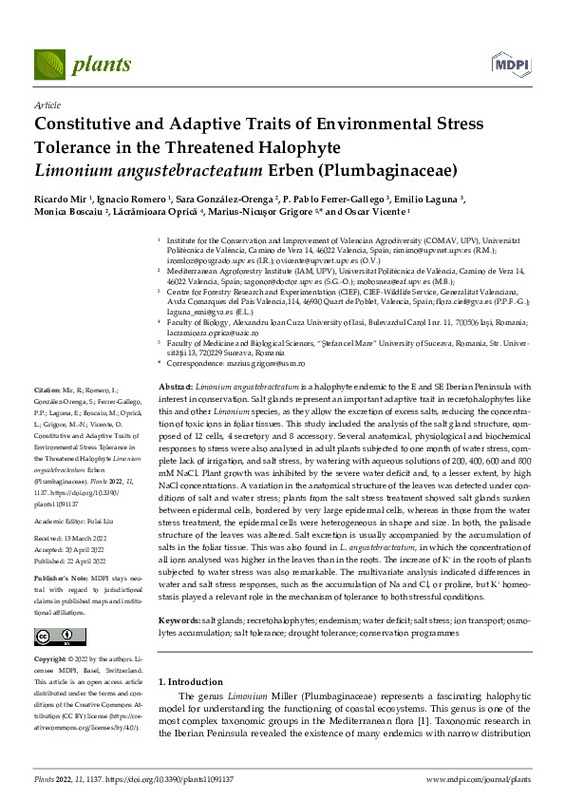JavaScript is disabled for your browser. Some features of this site may not work without it.
Buscar en RiuNet
Listar
Mi cuenta
Estadísticas
Ayuda RiuNet
Admin. UPV
Constitutive and Adaptive Traits of Environmental Stress Tolerance in the Threatened Halophyte Limonium angustebracteatum Erben (Plumbaginaceae)
Mostrar el registro sencillo del ítem
Ficheros en el ítem
| dc.contributor.author | Mir Moreno, Ricardo
|
es_ES |
| dc.contributor.author | Romero, Ignacio
|
es_ES |
| dc.contributor.author | González-Orenga, Sara
|
es_ES |
| dc.contributor.author | Ferrer-Gallego, P. Pablo
|
es_ES |
| dc.contributor.author | Laguna, Emilio
|
es_ES |
| dc.contributor.author | Boscaiu, Monica
|
es_ES |
| dc.contributor.author | Lacramioara, Oprica
|
es_ES |
| dc.contributor.author | Grigore, Marius-Nicusor
|
es_ES |
| dc.contributor.author | Vicente, Oscar
|
es_ES |
| dc.date.accessioned | 2023-06-13T18:03:34Z | |
| dc.date.available | 2023-06-13T18:03:34Z | |
| dc.date.issued | 2022-05 | es_ES |
| dc.identifier.uri | http://hdl.handle.net/10251/194190 | |
| dc.description.abstract | [EN] Limonium angustebracteatum is a halophyte endemic to the E and SE Iberian Peninsula with interest in conservation. Salt glands represent an important adaptive trait in recretohalophytes like this and other Limonium species, as they allow the excretion of excess salts, reducing the concentration of toxic ions in foliar tissues. This study included the analysis of the salt gland structure, composed of 12 cells, 4 secretory and 8 accessory. Several anatomical, physiological and biochemical responses to stress were also analysed in adult plants subjected to one month of water stress, complete lack of irrigation, and salt stress, by watering with aqueous solutions of 200, 400, 600 and 800 mM NaCl. Plant growth was inhibited by the severe water deficit and, to a lesser extent, by high NaCl concentrations. A variation in the anatomical structure of the leaves was detected under conditions of salt and water stress; plants from the salt stress treatment showed salt glands sunken between epidermal cells, bordered by very large epidermal cells, whereas in those from the water stress treatment, the epidermal cells were heterogeneous in shape and size. In both, the palisade structure of the leaves was altered. Salt excretion is usually accompanied by the accumulation of salts in the foliar tissue. This was also found in L. angustebracteatum, in which the concentration of all ions analysed was higher in the leaves than in the roots. The increase of K+ in the roots of plants subjected to water stress was also remarkable. The multivariate analysis indicated differences in water and salt stress responses, such as the accumulation of Na and Cl, or proline, but K+ homeostasis played a relevant role in the mechanism of tolerance to both stressful onditions | es_ES |
| dc.description.sponsorship | The authors thank Inmaculada Ferrando Pardo for helping in the study and conservation of the seeds in the Centre for Forest Research and Experimentation of the Valencian Region (CIEF). Thanks also to the Devesa-Albufera technical service of the Valencia City Council for all the access facilities for the in situ fieldwork in La Albufera Natural Park. We are indebted to the Electron Microscopy Service of Universitat Politecnica de Valencia and Marisol Gascon (IBMCP Microscopy Service) for their excellent technical support. We also thank Jose M. Segui-Simarro for using the optical microscope Nikon Eclipse E1000. RM holds a CDEIGENT (2018/023) fellowship from Generalitat Valenciana. IR's participation results from a mobility stay funded by the Erasmus+-KA1 Erasmus Mundus Joint Master Degrees Programme of the European Commission under the PLANT HEALTH Project. | es_ES |
| dc.language | Inglés | es_ES |
| dc.publisher | MDPI | es_ES |
| dc.relation.ispartof | Plants | es_ES |
| dc.rights | Reconocimiento (by) | es_ES |
| dc.subject | Salt glands | es_ES |
| dc.subject | Recretohalophytes | es_ES |
| dc.subject | Endemism | es_ES |
| dc.subject | Water deficit | es_ES |
| dc.subject | Salt stress | es_ES |
| dc.subject | Ion transport | es_ES |
| dc.subject | Osmolytes accumulation | es_ES |
| dc.subject | Salt tolerance | es_ES |
| dc.subject | Drought tolerance | es_ES |
| dc.subject | Conservation programmes | es_ES |
| dc.subject.classification | BIOQUIMICA Y BIOLOGIA MOLECULAR | es_ES |
| dc.subject.classification | BOTANICA | es_ES |
| dc.title | Constitutive and Adaptive Traits of Environmental Stress Tolerance in the Threatened Halophyte Limonium angustebracteatum Erben (Plumbaginaceae) | es_ES |
| dc.type | Artículo | es_ES |
| dc.identifier.doi | 10.3390/plants11091137 | es_ES |
| dc.relation.projectID | info:eu-repo/grantAgreement/GVA//CIDEGENT%2F2018%2F023/ | es_ES |
| dc.relation.projectID | info:eu-repo/grantAgreement/Erasmus+//KA1//Erasmus Mundus Joint Master Degrees/ | es_ES |
| dc.rights.accessRights | Abierto | es_ES |
| dc.contributor.affiliation | Universitat Politècnica de València. Instituto Universitario de Conservación y Mejora de la Agrodiversidad Valenciana - Institut Universitari de Conservació i Millora de l'Agrodiversitat Valenciana | es_ES |
| dc.contributor.affiliation | Universitat Politècnica de València. Escuela Técnica Superior de Ingeniería Agronómica y del Medio Natural - Escola Tècnica Superior d'Enginyeria Agronòmica i del Medi Natural | es_ES |
| dc.description.bibliographicCitation | Mir Moreno, R.; Romero, I.; González-Orenga, S.; Ferrer-Gallego, PP.; Laguna, E.; Boscaiu, M.; Lacramioara, O.... (2022). Constitutive and Adaptive Traits of Environmental Stress Tolerance in the Threatened Halophyte Limonium angustebracteatum Erben (Plumbaginaceae). Plants. 11(9):1-21. https://doi.org/10.3390/plants11091137 | es_ES |
| dc.description.accrualMethod | S | es_ES |
| dc.relation.publisherversion | https://doi.org/10.3390/plants11091137 | es_ES |
| dc.description.upvformatpinicio | 1 | es_ES |
| dc.description.upvformatpfin | 21 | es_ES |
| dc.type.version | info:eu-repo/semantics/publishedVersion | es_ES |
| dc.description.volume | 11 | es_ES |
| dc.description.issue | 9 | es_ES |
| dc.identifier.eissn | 2223-7747 | es_ES |
| dc.identifier.pmid | 35567138 | es_ES |
| dc.identifier.pmcid | PMC9103948 | es_ES |
| dc.relation.pasarela | S\470258 | es_ES |
| dc.contributor.funder | Erasmus+ | es_ES |
| dc.contributor.funder | Generalitat Valenciana | es_ES |
| dc.subject.ods | 15.- Proteger, restaurar y promover la utilización sostenible de los ecosistemas terrestres, gestionar de manera sostenible los bosques, combatir la desertificación y detener y revertir la degradación de la tierra, y frenar la pérdida de diversidad biológica | es_ES |








